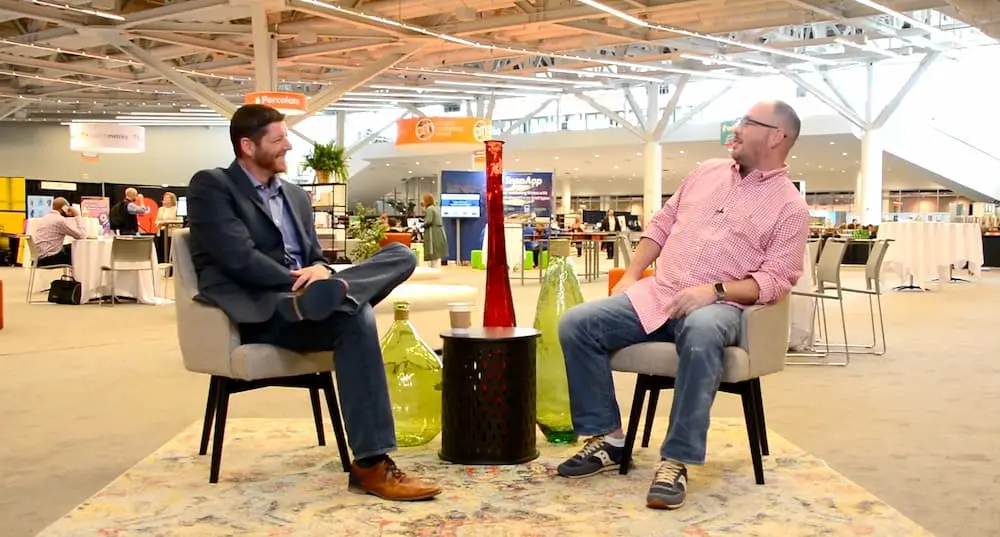Artificial intelligence and native advertising are two of the biggest topics currently dominating the content marketing world. Marketing Artificial Intelligence Institute (MAII) founder Paul Roetzer sat down with Chad Pollitt (LinkedIn), author of the Native Advertising Manifesto, to discuss AI in advertising, marketer to marketer.
IBM Watson, sponsored content, influencer marketing and more, these two marketers covered it all. The full recording of their conversation, “A Journey Through Native Advertising to Artificial Intelligence,” can be found here. We’ve pulled out the highlights below.
AI? Machine Learning?
To kick off the conversation, Roetzer and Pollitt discussed the next big thing for marketing: artificial intelligence.
“We’re surrounded by AI but the average marketer, one, doesn’t know what that [AI] means, and two, if they do, it’s hard to know how intelligent the software is really becoming.”
However, the average marketer is probably familiar with IBM Watson, the AI supercomputer that made $1 million winning Jeopardy three nights in a row. But Roetzer explained that AI is really an umbrella term. The two main subsets people often refer to are machine learning and deep learning.
Roetzer described machine learning as a machine that gets smarter on its own, without human guidance. He used social media publishing as an example:
“If an AI tool is just looking at a data set and pulling the optimal time to post from a rule created by humans, it’s not machine learning. Machine learning would mean real-time monitoring of social media and the algorithm changing those optimal publishing times based on past performance for your company specifically. It’s actually the machine, with no human guidance, getting smarter and updating what it recommends you to do.”
Roetzer follows up his comment with the warning that while many companies are using some sort of artificial intelligence, it is very rare to find real machine learning in marketing software today.
This is where MAII comes in. It serves as an investigator to filter through the AI hype and connect marketers with real AI tools that make their jobs easier and more efficient.
Getting Started with Native Advertising
Next, the conversation took a turn toward native advertising.
Pollitt defined native advertising as, “Content that matches the form, feel, and function of the media that surrounds it.”
He used the sponsored content that appears in your Facebook feed as an example. It’s native advertising because someone paid for it and it looks like it belongs there.
This prompts Roetzer to question whether native and sponsored content are the same thing.
To answer, Pollitt brings up the 2014 Orange is the New Black New York Times article. To the average person, the article and Facebook sponsored posts are completely different things. In reality, they are the same—both are sponsored, paid for, and appear naturally in users’ feeds.
Pollitt pointed out the disconnect in the language regarding native advertising. Brand marketers call it sponsored content, while publishers call it branded content. Ultimately, publishers are doing some form of paid media and marketers are focused on owned media, with paid as a distribution channel.
Pollitt’s advice for getting started with native advertising?
“Start simple. Run some experiments using Facebook, Twitter, and maybe Linkedin if you’re B2B especially. Start off with some experiments and get a feel for those channels.”
Beyond that, Pollitt recommends trying a DSP (demand-side platform) to connect dozens of other channels (Outbrain, Taboola, Adblade, etc.). From there, marketers, with the assistance of some AI, can set up native advertising campaigns, optimize, and control everything from one dashboard.
Promotion. Promotion. Promotion.
When asked about the obstacles to the continued rise of native advertising, Pollitt simply answered, “Our mindset.”
He explained how too many marketers are spending 80-90% of their resources on content creation and only 10-20% on the distribution of that content.
Roetzer agrees, “Yeah, we always tell people in the proposal process before we even take them on as a client, ‘If you're gonna spend $8,000 a month with us on creation, you need at least $8,000 a month in promotion.’ But ideally, far more than that—it has to at least be a 50-50.”
When discussing how that promotion money could be spent, the topic of influencer marketing emerged.
“I feel like that's one of those buzzwords that is just public relations—but we call it “influencer marketing” because it makes for better blog post titles,” Roetzer commented.
Pollitt, also an adjunct business professor at Rutgers University and Indiana University, added, “I like to tell my students the first day of class that the internet has put the power of the media in the hands of every human being that has access.”
Pollitt goes on to explain how under the umbrella of native advertising, there’s a section called influencer advertising. This is where influencers, individuals with large and small social media followings, are paid for their interactions. For posting a photo to their profile, they may receive money, Amazon gift cards, or points to cash in for gifts later.
Stay Tuned For...
Before saying their goodbyes, the two marketers shared some of the projects they’ve been working on.
The Marketing AI Institute is building a benefactor program, enabling AI companies to contribute guest content to the blog. There may also be an AI book for marketers in the works.
PR 20/20, Roetzer’s agency, recently released its first online education class, Point Pricing for Agencies, a three-course, on-demand series for driving profits, productivity, and performance with value-based pricing.
Pollitt recently released an eBook, “Everything You Need to Know About Marketing Analytics and Artificial Intelligence,” which can be downloaded for free here.
Ashley Sams
Ashley Sams is director of marketing at Ready North. She joined the agency in 2017 with a background in marketing, specifically for higher education and social media. Ashley is a 2015 graduate of The University of Mount Union where she earned a degree in marketing.


